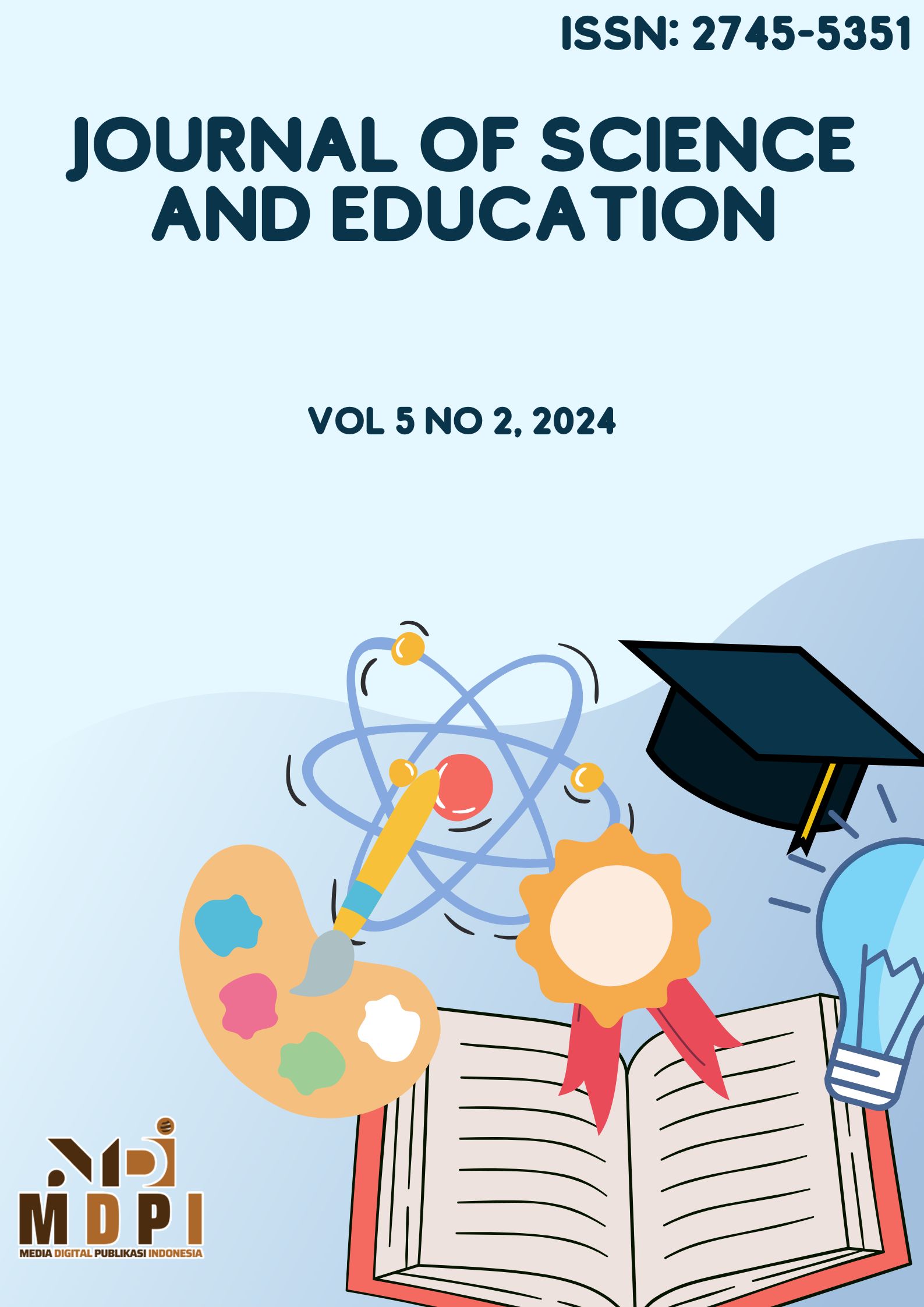Application of PowerPoint Media in Think Pair Share (TPS) Cooperative Learning to Increase Students' Learning Activity and Independence
DOI:
https://doi.org/10.58905/jse.v5i2.476Keywords:
Activeness, Cooperative Learning, Learning Independence, PowerPoint Media, Think Pair ShareAbstract
This study examines how PowerPoint media can increase student activeness and independence in Think Pair Share (TPS). This report uses a case study from a junior high school with several pupils as subjects. PowerPoint is utilized to show learning materials interactively and interestingly, and the TPS learning paradigm encourages student involvement. Data is collected by observation, interviews, and documentation analysis and examined descriptively qualitatively. The study found that PowerPoint media in TPS cooperative learning increases student involvement in group discussions and partner idea sharing. Because it encourages students to actively seek information and share opinions, this media also boosts learning freedom. The TPS learning paradigm using PowerPoint media creates a more dynamic learning environment and improves classroom learning, according to this study. This study examines how PowerPoint media can improve students' active and independent learning in cooperative Think Pair Share (TPS) learning. This report uses a case study from a junior high school with several pupils as subjects. Power-Point media is used to make learning materials interactive and exciting, and the TPS learning approach encourages student involvement. Data was collected by observation, interviews, and documentation analysis and examined qualitatively. The study found that PowerPoint media in TPS cooperative learning increases student activity in group discussions and when sharing opinions with partners. Because this media encourages students to actively seek information and share opinions, it also boosts learning freedom. The TPS learning paradigm using PowerPoint media creates a more dynamic learning environment and improves classroom learning, according to this study
Downloads
References
Alek, A. (2023). The Impact of Technology on English Language Education in Indone-sia: A Theoretical Review. BiCED Proceeding, 1, 45–63.
Al-Hatem, A. I., Masood, M., & Al-Samarraie, H. (2018). Fostering student nurses’ self-regulated learning with the Second Life environment: An empirical study. Journal of Information Technology Education: Research, 17, 285–307. https://doi.org/10.28945/4110
Ashman, G. (2020). The Power of Explicit Teaching and Direct Instruction. Torrossa, 1–152.
Awofala, A. O., & Lawani, A. O. (2020). Examining the Efficacy of Co-operative Learning Strategy on Undergraduate Students’ Achievement in Mathematics. Interna-tional Journal of Pedagogy and Teacher Education, 4(1). https://doi.org/10.20961/ijpte.v4i1.33402
Baker, J. P., Goodboy, A. K., Bowman, N. D., & Wright, A. A. (2018). Does teaching with PowerPoint increase students’ learning? A meta-analysis. Computers & Education, 126, 376–387. https://doi.org/10.1016/j.compedu.2018.08.003
Brito, S. M. (2019). Active Learning: Beyond the Future. BoD – Books on Demand.
Crook, C., & Sutherland, R. (2017). Technology and Theories of Learning. In E. Duval, M. Sharples, & R. Sutherland (Eds.), Technology Enhanced Learning: Research Themes (pp. 11–27). Springer International Publishing. https://doi.org/10.1007/978-3-319-02600-8_2
Deci, E. L., & Ryan, R. M. (2008). Self-determination theory: A macrotheory of human motivation, development, and health. Canadian Psychology / Psychologie Canadienne, 49(3), 182–185. https://doi.org/10.1037/a0012801
Hosic, J. fleming. (1917). Reorganization of English in Secondary Schools: Report by the Nation Joint Committee on English Representing the Commission on the Reorganization of Secondary Education of the National Education Association and the National Council of Teahers of English. U.S. Government Printing Office.
Imaniyati, N., Ramdhany, M. A., Rasto, R., Nurjanah, S., Solihah, P. A., & Susilawati, A. (2024). Neuroscience Intervention for Implementing Digital Transformation and Or-ganizational Health Completed with Literature Review, Bibliometrics, and Experi-ments. Indonesian Journal of Science & Technology, 9(2). https://doi.org/10.17509/ijost.v9i2.67763
Kaur, A., Bhatia, M., & Stea, G. (2022). A Survey of Smart Classroom Literature. Edu-cation Sciences, 12(2), 86. https://doi.org/10.3390/educsci12020086
Lestari, K. I., Arcana, I. N., Susetyo, A. E., & Kuncoro, K. S. (2022). Development of Online Learning Quiz and Educational Game Using Word Walls in Mathematics for Grade 10. INSANIA : Jurnal Pemikiran Alternatif Kependidikan, 27(2), 145–159. https://doi.org/10.24090/insania.v27i2.6924
Mayer, R. E. (2005). The Cambridge Handbook of Multimedia Learning. Cambridge University Press.
Mctighe, J., & Brown, P. L. (2021). Using Understanding by Design to Make the Standards Come Alive. Science Scope, 45(2), 40–46. https://doi.org/10.1080/08872376.2021.12291448
Mirici, S., & Sonmez, D. (2025). Global Perspectives in Educational Research. Akade-misyen Kitabevi.
Øzerk, K., Øzerk, G., & Silveira-Zaldivar, T. (2021). Developing Social Skills and Social Competence in Children with Autism. International Electronic Journal of Elementary Education, 13(3), 341–363. https://doi.org/10.26822/iejee.2021.195
Sari, D. N. (2020). The Use Of Learning Log Strategy On Writing Argumentative Text For Grade X Student Of SMA N 2 LAWE BULAN [Skripsi, Universitas Islam Negeri Su-matera Utara]. http://repository.uinsu.ac.id/9811/
Slavin, R. E. (1983). When does cooperative learning increase student achievement? Psychological Bulletin, 94(3), 429–445. https://doi.org/10.1037/0033-2909.94.3.429
Timmermans, A. (2023). Enhancing Self-Directed Learning Readiness in Entrepreneur-ship Education. Journal of Higher Education Theory and Practice, 23(9). https://doi.org/10.33423/jhetp.v23i9.6137
van de Pol, J., Volman, M., Oort, F., & Beishuizen, J. (2015). The effects of scaffolding in the classroom: Support contingency and student independent working time in rela-tion to student achievement, task effort and appreciation of support. Instructional Sci-ence, 43(5), 615–641. https://doi.org/10.1007/s11251-015-9351-z
Wanner, T. (2015). Enhancing Student Engagement and Active Learning through Just-in-Time Teaching and the use of PowerPoint. International Journal of Teaching and Learning in Higher Education, 27(1).
Zimmerman, B. J. (1990). Self-Regulated Learning and Academic Achievement: An Overview. Educational Psychologist, 25(1), 3–17. https://doi.org/10.1207/s15326985ep2501_2
Downloads
Published
How to Cite
Issue
Section
License
Copyright (c) 2025 Intan Azka Fathiyah, Moh. Sahlan, Lailatul Usriyah, Mundir Mundir

This work is licensed under a Creative Commons Attribution-ShareAlike 4.0 International License.

















